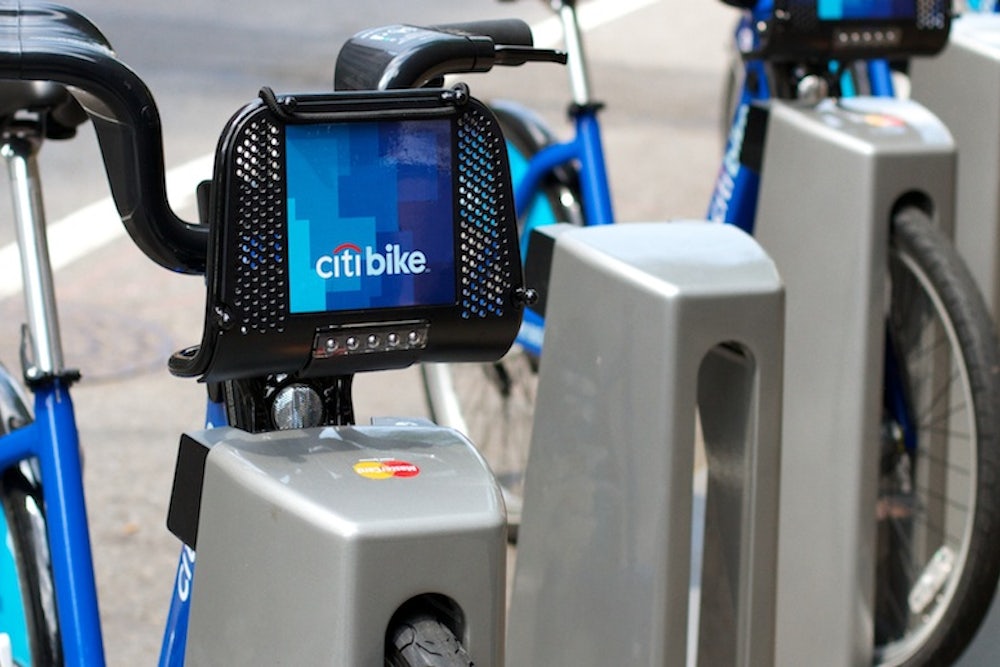What does New York City’s new bike-share program have in common with the special police forces being set up in India to protect female tourists from rape? The answer can be found in Margaret Atwood’s recent science-fiction trilogy: Oryx & Crake, The Year of the Flood, and Maddadam (the third volume will be published in September). In these dystopic novels, cities have been divided into two parts. There are the gated and firmly policed compounds inhabited by scientists and the executives of biotech corporations, and there is everywhere else. If you aren’t a “compounder,” a happy inhabitant of one such amenity-rich compound, then you’re a “pleeblander,” a plebian relegated to the pleeblands, whose streets are filled with garbage and dominated by gangs, themselves run by corrupt private security forces totally uninterested in your safety or wellbeing.
“New York’s Citibike program?” you say. “What’s that got to do with compounds and pleeblands? It’s fantastic! It will clear away the cars, which pollute and kill pedestrians and squander valuable street space on parking! It will make New York cleaner and safer and better, not worse!” All true. So how dare I compare it to India’s plan to protect tourists, and what’s wrong with that anyway? Nothing, obviously. It’s wonderful too. It’s awful being a stranger who’s easily preyed upon. My objection is not to these marvelous public resources; it’s to their un-public-minded allocation.
India is adding a special police unit because it is worried that its reputation for violence against women will curtail tourism; the average female citizen, however, has evidently yet to get much police protection against rape. New York City, which has to prove to a skeptical public that bikeshares work, put its shiny new bikes where they’ll get the most use, which means close to where the most people work. In New York, that’s also where the richest people live. So the people with the best access to the bikes are those who live in our own version of a “compound”: midtown and downtown Manhattan and the tonier parts of Brooklyn. There are stations in a few economically mixed and fast-gentrifying neighborhoods, such as Bedford-Stuyvesant and the lower East Side, but there are none in upper Manhattan, Queens, Staten Island, or the Bronx.
If safety and access to public transportation count as wealth, then the rich just got richer and the poor have stayed poor. New York’s transportation commissioner, Janik Sadik-Khan, recently described bike-sharing as a way to solve the “last mile” problem—to get people from bus and subways stops to their homes. But in the outer boroughs, the last-mile problem is more like a last-several-miles problem, since those places are more spread out and grossly underserved by subways and buses. The poor people who live in these boroughs tend not to have cars, so they have few ways to get to where the jobs are. That’s one reason they’re poor. This Catch-22 is a part of what, nearly 50 years ago, Daniel Patrick Moynihan called “the poverty trap.”
We New Yorkers have all heard a great deal about the second phase of the program, which is supposed to put bike stations into upper Manhattan, Queens, and more parts of Brooklyn—though not in Staten Island or the Bronx, which is the poorest borough of all. But drill down on this much-vaunted expansion, as the Wall Street Journal recently did, and you’ll discover that there is actually no money left for it, and no guarantee that any will come in. For all their advantages, bikes still don’t count as enough of a public good for the New York City government to invest public funds in them. Citibank paid for the Citibikes, which are the same shade of blue as the Citibank logo, in a $41 million public-relations coup (“I would love to know what a marketing firm would value this advertising at,” Dalton Conley, a professor of sociology at New York University, told me. “It must be huge! Think of all those eyeballs!”). That money was spent; some of it was lost when Hurricane Sandy flooded the warehouses where the bikes were stored.
So how will the city keep its promise? “We’re continuing to work with sponsors on that,” Sadik-Khan said recently. (The city has also applied to the federal government for a small-business loan to help cover the Sandy-related losses.) So while the city begs the compounders for largesse, we who live in the pleeblands—I live on the Upper West Side, 2.5 miles from the nearest station—will just have to settle in for an indefinite wait.
This post has been updated.
